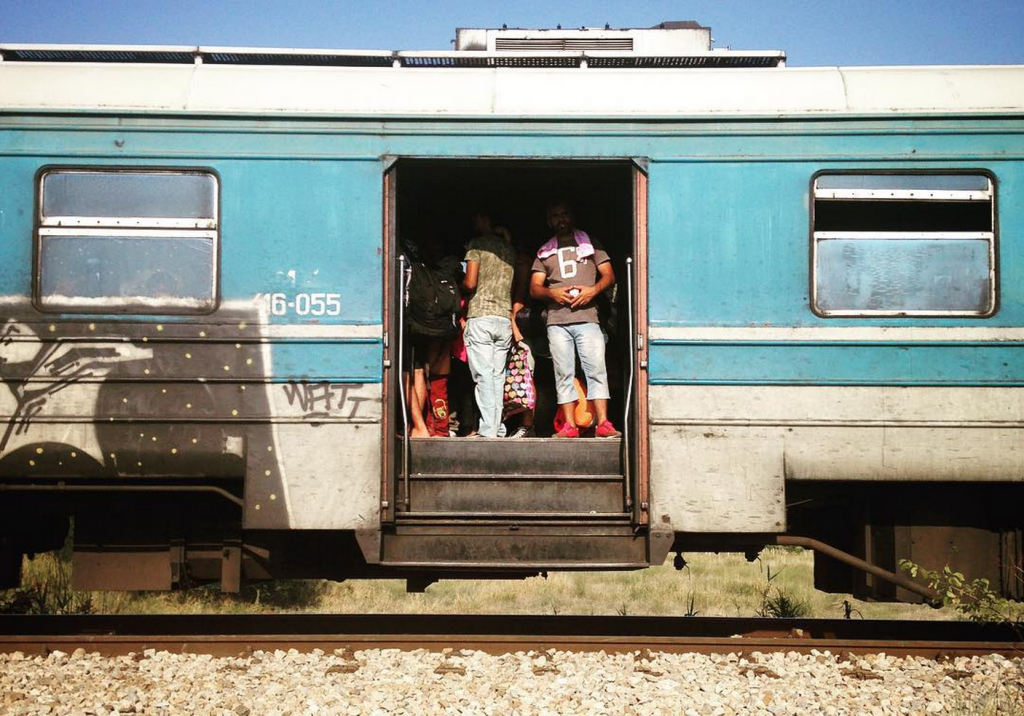Along with a group of migrants and refugees, Anemona Hartocollis is now making a journey through Europe. It started a week ago. It feels like longer.
“Every day seems like a new discovery,” said Hartocollis, who was in Hungary when we spoke on Monday. “And it makes it much more exciting and much more difficult, because you have to find your way just as they’re finding their way.”
She’s following them, she said, and they’re all following each other.
Her serial about the journey, “Traveling in Europe’s River of Migrants,” started running as part of The New York Times’ Reporter’s Notebook feature on Aug. 27. Each day, short dispatches show the trip we often read about from one end or another.
“We realized that much of the story is the journey itself,” said Hanna Ingber, an assistant editor on The Times’ international desk, “so rather than always having a story from one spot, we wanted to really tell the story of the journey.”
From a post published on Monday:
The Hungarian police looked down at Ahmad Majid’s 6-foot-2 frame through the glistening silver coils of razor wire and laughed uproariously.
Then they waved him back to the Serbian side of the border, from which he and the group he was leading had been caught trying to cross into Hungary illegally.
It must have looked like folly from the vantage point of the police to try to bring 20 men, women and children across such a well-protected border.
Mr. Majid took the humiliation, and while he distracted the police, his band scrambled out of the ditch by the border and ducked behind some trees, squatting so their dark clothing would blend in with the nighttime foliage.
They waited, crouching in the dark field, for the headlights of the police patrol to pass and the roar of the helicopter to fade, waiting for another chance.
The journey for The Times started in Greece, where Hartocollis met with photojournalist Sergey Ponomarev. They later met videographer Nabih Bulos in Belgrade.
In Greece, Hartocollis and Ponomarev looked for people to follow on the train tracks in Idomeni. With the help of a translator, they found a group of Syrians who were open to the presence of the journalists and capable of keeping in touch with cellphones.
And most people have. One family she was watching just disappeared. Other people she met early in the journey popped up again recently. Hartocollis has tried, when she sees them, to have her subjects read the stories after they’re published. So far, everyone has been OK with what she wrote.
“I think it is a story that they are motivated to share, and they appreciate the attention,” she said, “and so that’s been very positive.”
Hartocollis is traveling as the migrants and refugees are traveling, but she’s not staying where they’re staying, which is often in camps.
“There’s a balance between being able to do my job and doing what they do,” she said.
She hasn’t illegally crossed borders with them, either, though it has been tempting. Instead, she travels to the edge then turns around for customs.
“So there are elements where you pull back, and I think that’s regrettable,” she said. “I don’t know what the right answer is on that, but I’m trying to do the right thing. It’s like it always is when you tell a story: the story is not your life, it’s their life.”
Each chapter of Hartocollis’ series is short, from a post that was about 700 words to one that was just 46. The passage above ran on Aug. 28.
“All of this is new, and so we’re figuring it out as we go,” Ingber said. “I wouldn’t say that we know what is the ideal length for one of these posts. We’re going by what we feel makes sense. We’re thinking a lot about mobile and how we’re telling the story on mobile, and because of that, we’re thinking about visuals, we’re thinking about how the story looks…”
They’re also aware that some readers have followed from the beginning while others have just joined in. The intention is for each piece to stand independently, to help the reader get oriented quickly and allow them to immerse themselves however they like.
“Each one, we hope, is a little nugget that can stand alone and has its own mini story in it,” Ingber said, “and together they make one big story as well.”
In July, The Times used Reporter’s Notebook to report on what it was like to follow the Pope through Latin America. For that, they used several platforms, including WhatsApp. But there were a lot of technical hurdles, Ingber said. This time, they focused on the places that seemed like the best fit for the story and the staff covering it – Twitter, Instagram and Facebook.
They’ve also been figuring out the process for getting the short pieces out daily. It’s not a live blog, “so everything that Anemona is writing goes through an edit and then goes though a copy editor,” Ingber said.
They’re telling a story in a new way, she said, but doing that following Times’ standards.
“We want readers to feel like they’re there with Anemona as she’s going, but whether or not it’s actually that moment or three hours earlier, I don’t think on this type of model that it really matters.”
It feels like it has been longer than a week, but the people Hartocollis is following move quickly – because of money, legal issues, political concerns and personal ones. So the series does, too.
When does the journey end?
“I think there will be a natural ending somehow,” Hartocollis said, “so as long as it takes to get there.”
Related: The language of migration: refugee vs. migrant








